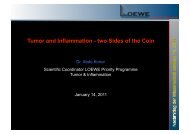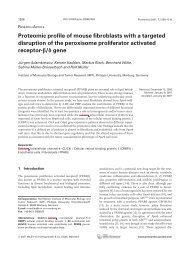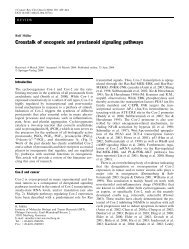Getting under the Skin of Alternative Splicing: Identification of ... - IMT
Getting under the Skin of Alternative Splicing: Identification of ... - IMT
Getting under the Skin of Alternative Splicing: Identification of ... - IMT
You also want an ePaper? Increase the reach of your titles
YUMPU automatically turns print PDFs into web optimized ePapers that Google loves.
Molecular Cell<br />
Previews<br />
Shiotani and Zou’s work provides<br />
crucial mechanistic insight into <strong>the</strong><br />
emerging consensus on <strong>the</strong> dynamic<br />
recognition <strong>of</strong> double-strand breaks. In<br />
addition, it holds <strong>the</strong> promise <strong>of</strong> fur<strong>the</strong>r<br />
biochemical dissection <strong>of</strong> <strong>the</strong> complicated<br />
interplay between proteins at <strong>the</strong><br />
ends <strong>of</strong> broken DNA.<br />
REFERENCES<br />
Choi, J.H., Lindsey-Boltz, L.A., and Sancar, A.<br />
(2007). Proc. Natl. Acad. Sci. USA 104, 13301–<br />
13306.<br />
Dupre, A., Boyer-Chatenet, L., and Gautier, J.<br />
(2006). Nat. Struct. Mol. Biol. 13, 451–457.<br />
Gravel, S., Chapman, J.R., Magill, C., and Jackson,<br />
S.P. (2008). Genes Dev. 22, 2767–2772.<br />
Jazayeri, A., Falck, J., Lukas, C., Bartek, J., Smith,<br />
G.C., Lukas, J., and Jackson, S.P. (2006). Nat. Cell<br />
Biol. 8, 37–45.<br />
Lee, J.H., and Paull, T.T. (2005). Science 308,<br />
551–554.<br />
MacDougall, C.A., Byun, T.S., Van, C., Yee, M.C.,<br />
and Cimprich, K.A. (2007). Genes Dev. 21, 898–<br />
903.<br />
Mimitou, E.P., and Symington, L.S. (2008). Nature<br />
455, 770–774.<br />
Myers, J.S., and Cortez, D. (2006). J. Biol. Chem.<br />
281, 9346–9350.<br />
Shiotani, B., and Zou, L. (2009). Mol. Cell 33, 547–<br />
558.<br />
Yoo, H.Y., Kumagai, A., Shevchenko, A., Shevchenko,<br />
A., and Dunphy, W.G. (2007). J. Biol.<br />
Chem. 282, 17501–17506.<br />
Zhu, Z., Chung, W.H., Shim, E.Y., Lee, S.E., and<br />
Ira, G. (2008). Cell 134, 981–994.<br />
<strong>Getting</strong> <strong>under</strong> <strong>the</strong> <strong>Skin</strong><br />
<strong>of</strong> <strong>Alternative</strong> <strong>Splicing</strong>: <strong>Identification</strong><br />
<strong>of</strong> Epi<strong>the</strong>lial-Specific <strong>Splicing</strong> Factors<br />
Florian Heyd 1 and Kristen W. Lynch 1, *<br />
1<br />
Department <strong>of</strong> Biochemistry, UT Southwestern Medical Center, Dallas TX 75390, USA<br />
*Correspondence: kristen.lynch@utsouthwestern.edu<br />
DOI 10.1016/j.molcel.2009.03.001<br />
<strong>Alternative</strong> splicing patterns are regulated by factors that direct <strong>the</strong> activity <strong>of</strong> <strong>the</strong> spliceosome. In a recent<br />
issue <strong>of</strong> Molecular Cell, Warzecha et al. (2009) identify two new splicing regulators whose epi<strong>the</strong>lial-specific<br />
expression induces several tissue-specific splicing events.<br />
<strong>Alternative</strong> splicing is a prominent feature<br />
<strong>of</strong> eukaryotic genomes. The differential<br />
inclusion or skipping <strong>of</strong> variable exons<br />
occurs in <strong>the</strong> majority <strong>of</strong> human genes<br />
and is a major contributor to proteome<br />
diversity and regulation <strong>of</strong> gene expression<br />
(Matlin et al., 2005). Moreover, recent technical<br />
advances such as splicing-sensitive<br />
microarrays and deep sequencing have<br />
identified distinct tissue-specific splicing<br />
patterns on a genome-wide scale (Pan<br />
et al., 2008; Wang et al., 2008). In many<br />
cases, <strong>the</strong> genes that show coregulation<br />
at <strong>the</strong> level <strong>of</strong> splicing in a particular tissue<br />
cluster into physiologically meaningful<br />
ontologies (Ule et al., 2005); however,<br />
with few exceptions, <strong>the</strong> functional significance<br />
<strong>of</strong> this coregulation has not been<br />
formally shown. Fur<strong>the</strong>rmore, <strong>the</strong>re is little<br />
<strong>under</strong>standing <strong>of</strong> how such cell-typespecific<br />
splicing pr<strong>of</strong>iles are established.<br />
While <strong>the</strong> weight <strong>of</strong> current evidence<br />
argues against tissue-specific ‘‘masterregulators’’<br />
that act alone to dictate<br />
splicing patterns, it is unclear whe<strong>the</strong>r<br />
tissue-specific splicing is due to <strong>the</strong> differential<br />
fine-tuning <strong>of</strong> many ubiquitously expressed<br />
splicing factors, to <strong>the</strong> presence<br />
<strong>of</strong> a few dominant determinant proteins,<br />
or to somewhere in between (Matlin et al.,<br />
2005; Figure 1).<br />
A handful <strong>of</strong> cell-type-specific splicing<br />
factors have been identified in <strong>the</strong> past<br />
decade; however, <strong>the</strong>se have been limited<br />
to proteins that specify neural- or musclespecific<br />
splicing events (Li et al., 2007;<br />
Pascual et al., 2006). In a recent issue <strong>of</strong><br />
Molecular Cell, Carstens and colleagues<br />
describe <strong>the</strong> exciting identification <strong>of</strong> two<br />
new, related cell-type-specific splicing<br />
regulators that induce <strong>the</strong> epi<strong>the</strong>lial<br />
splicing pattern <strong>of</strong> several target mRNAs<br />
(Warzecha et al., 2009). This work not<br />
only substantially expands <strong>the</strong> list <strong>of</strong><br />
tissue-specific splicing regulators to<br />
include proteins that are predominantly<br />
epi<strong>the</strong>lial, but in so doing, sets <strong>the</strong> stage<br />
for a deeper look into <strong>the</strong> regulation <strong>of</strong><br />
cell-type-specific alternative splicing and<br />
<strong>the</strong> physiologic consequences <strong>of</strong> such<br />
genetic control.<br />
One <strong>of</strong> <strong>the</strong> best documented examples<br />
<strong>of</strong> tissue-specific alternative splicing is<br />
<strong>the</strong> mutually exclusive inclusion <strong>of</strong> exons<br />
IIIb and IIIc <strong>of</strong> FGFR2 (fibroblast growth<br />
factor receptor 2), which are expressed<br />
in ei<strong>the</strong>r epi<strong>the</strong>lial (IIIb) or mesenchymal<br />
(IIIc) tissues and recognize distinct ligands<br />
(Orr-Urtreger et al., 1993). Work from<br />
several groups has identified many ubiquitous<br />
splicing factors that influence<br />
<strong>the</strong> choice <strong>of</strong> FGFR2 exon inclusion (Figure<br />
1; Hovhannisyan and Carstens, 2007;<br />
Mauger et al., 2008 and references<br />
<strong>the</strong>rein). However, none <strong>of</strong> <strong>the</strong>se proteins<br />
fully explains <strong>the</strong> tight tissue-specific<br />
674 Molecular Cell 33, March 27, 2009 ª2009 Elsevier Inc.
Molecular Cell<br />
Previews<br />
Figure 1. Potential Mechanisms for Achieving Tissue-Specific <strong>Splicing</strong> Patterns<br />
Differential splicing <strong>of</strong> two exons in an epi<strong>the</strong>lial versus nonepi<strong>the</strong>lial (nonspecific) pattern could <strong>the</strong>oretically<br />
be achieved by (A) an epi<strong>the</strong>lial-specific primary regulator that drives inclusion <strong>of</strong> an o<strong>the</strong>rwise<br />
unused exon and represses use <strong>of</strong> a ‘‘default’’ exon, (B) tissue-specific differences in <strong>the</strong> abundance<br />
and balance <strong>of</strong> multiple ubiquitous regulatory factors, or (C) a tissue-specific regulatory protein (yellow)<br />
that augments or counters <strong>the</strong> activity <strong>of</strong> o<strong>the</strong>r ubiquitous factors. The regulation <strong>of</strong> FGFR2 is most consistent<br />
with (C), in which <strong>the</strong> yellow protein corresponds to ESRP1/2, and o<strong>the</strong>r regulatory proteins include<br />
PTB, hnRNP A1, Fox, Tia-1, hnRNP M, and hnRNP F/H (see Warzecha et al. [2009] and references <strong>the</strong>rein).<br />
control <strong>of</strong> FGFR2 splicing. To seek additional<br />
players in <strong>the</strong> epi<strong>the</strong>lial-specific<br />
splicing <strong>of</strong> FGFR2, Warzecha et al. utilized<br />
a high-throughput cDNA expression<br />
screen in a cell line harboring a reporter<br />
construct that allowed luciferase expression<br />
only in <strong>the</strong> case <strong>of</strong> exon IIIb inclusion.<br />
Strikingly, this screen identified 18 unique<br />
cDNAs that were sufficient to induce<br />
expression <strong>of</strong> exon IIIb in a cell line that<br />
normally expressed only exon IIIc. Of<br />
<strong>the</strong>se positive clones, two related genes,<br />
Rbm35a and Rbm35b (later termed<br />
epi<strong>the</strong>lial splicing regulatory proteins 1<br />
and 2 [ESRP1/2]) were chosen for fur<strong>the</strong>r<br />
study based on <strong>the</strong> fact that <strong>the</strong>ir induction<br />
<strong>of</strong> IIIb inclusion was dependent on <strong>the</strong><br />
presence <strong>of</strong> a known exon IIIb enhancer<br />
element within <strong>the</strong> RNA. Both ESRP1<br />
and -2 were able to bind this RNA<br />
sequence, but not a mutated version,<br />
providing evidence for direct regulation.<br />
Remarkably, ESRP1/2 appear to be<br />
epi<strong>the</strong>lial-specific proteins (hence <strong>the</strong><br />
renaming), as both qPCR and in situ hybridization<br />
revealed a high level <strong>of</strong> ESRP1/2<br />
mRNA expression only in epi<strong>the</strong>lial tissues<br />
and cell lines. Fur<strong>the</strong>rmore, expression<br />
<strong>of</strong> ESRP1/2 mRNA decreased in a model<br />
<strong>of</strong> epi<strong>the</strong>lial-to-mesenchymal transition<br />
(EMT). Unfortunately, antibodies to cleanly<br />
detect endogenous ESRP1/2 proteins are<br />
currently not available; <strong>the</strong>refore, rigorous<br />
pro<strong>of</strong> <strong>of</strong> cell-type-specific expression <strong>of</strong><br />
<strong>the</strong> protein products awaits fur<strong>the</strong>r studies.<br />
However, consistent with tissue-specific<br />
activity <strong>of</strong> ESRP1/2, knockdown <strong>of</strong><br />
ESRP1/2 in epi<strong>the</strong>lial cells led to a switch<br />
in splicing to <strong>the</strong> mesenchymal FGFR2 is<strong>of</strong>orm<br />
(exon IIIc), and conversely, overexpression<br />
<strong>of</strong> ESRP1/2 in cells lacking <strong>the</strong>ir<br />
endogenous expression induced <strong>the</strong><br />
FGFR2 epi<strong>the</strong>lial splicing pattern (exon<br />
IIIb).<br />
Importantly, knockdown <strong>of</strong> ESRP1/2 in<br />
epi<strong>the</strong>lial cell lines also induced <strong>the</strong> nonepi<strong>the</strong>lial<br />
pattern <strong>of</strong> splicing <strong>of</strong> three additional<br />
pre-mRNAs tested. Fur<strong>the</strong>rmore, <strong>the</strong>se<br />
same three genes showed a change in<br />
is<strong>of</strong>orm expression when epi<strong>the</strong>lial cells<br />
were induced to transition to mesenchymal<br />
cells, and this change was reversed upon<br />
ectopic expression <strong>of</strong> ESRP1/2. Toge<strong>the</strong>r,<br />
<strong>the</strong>se data suggest that ESRP1/2 are<br />
regulators <strong>of</strong> concerted epi<strong>the</strong>lial-specific<br />
splicing events, although <strong>the</strong> extent<br />
and nature <strong>of</strong> such regulation remains<br />
unknown. Mapping <strong>of</strong> <strong>the</strong> ESRP1/2-<br />
binding site within <strong>the</strong>se four known<br />
ESRP-regulated RNAs and large-scale<br />
analysis <strong>of</strong> mRNA from cells depleted<br />
for ESRP1/2 will be an important next<br />
step to assess whe<strong>the</strong>r <strong>the</strong>se genes are<br />
indeed direct targets <strong>of</strong> ESRP1/2 and to<br />
determine <strong>the</strong> scope <strong>of</strong> <strong>the</strong>ir effect on<br />
epi<strong>the</strong>lial splicing. Interestingly, <strong>the</strong> ESRP<br />
Drosophila homolog Fusilli was able to<br />
substitute for ESRP1/2 in overexpression<br />
studies, indicating a conserved mode <strong>of</strong><br />
action as well as conserved RNA-binding<br />
sites. As Fusilli has also been shown to be<br />
highly enriched in epi<strong>the</strong>lial tissues in flies,<br />
it is possible that a program <strong>of</strong> epi<strong>the</strong>lial<br />
splicing events has been highly conserved<br />
through evolution and may play a more<br />
pr<strong>of</strong>ound physiologic role than previously<br />
recognized.<br />
It is worth noting that <strong>the</strong> initial screen by<br />
Warzecha et al. identified over a dozen<br />
o<strong>the</strong>r proteins that were also able to<br />
induce exon IIIb inclusion but were not<br />
analyzed fur<strong>the</strong>r. Indeed, <strong>the</strong> remarkably<br />
high percentage <strong>of</strong> confirmed positives<br />
coming out <strong>of</strong> <strong>the</strong>ir screen (18 <strong>of</strong> 22 initial<br />
hits) suggests a robust assay design that<br />
may be applicable in o<strong>the</strong>r systems to<br />
address similar questions. However, it is<br />
interesting to note that none <strong>of</strong> <strong>the</strong> previously<br />
characterized FGFR2 regulatory<br />
proteins were identified in <strong>the</strong> screen.<br />
This is most likely due to an important<br />
caveat <strong>of</strong> screening for splicing regulators,<br />
namely that many are difficult to overexpress<br />
or knockdown efficiently due to<br />
homeostatic autoregulation and/or loss<br />
<strong>of</strong> cell viability. Importantly, this suggests<br />
<strong>the</strong> screen was not saturating <strong>of</strong> all<br />
FGFR2 regulatory proteins and that even<br />
more may exist.<br />
The presence <strong>of</strong> fur<strong>the</strong>r IIIb-inducing<br />
proteins is consistent with a combinatorial<br />
mode <strong>of</strong> splicing regulation in which<br />
a number <strong>of</strong> RNA-binding proteins are<br />
involved in regulating <strong>the</strong> outcome <strong>of</strong><br />
FGFR2 alternative splicing, with ESRP1/2<br />
anticipated to have a strong, but not absolute,<br />
influence on <strong>the</strong> ultimate decision.<br />
Even if many <strong>of</strong> <strong>the</strong> additional genes identified<br />
in <strong>the</strong> current screen turn out to be indirect<br />
regulators <strong>of</strong> IIIb inclusion, ESRP1/2<br />
are only two <strong>of</strong> several proteins that have<br />
been shown thus far to directly regulate<br />
FGFR2 splicing (Figure 1). Similarly, <strong>the</strong><br />
decision <strong>of</strong> whe<strong>the</strong>r to include exon IIIb or<br />
IIIc has been shown to be dependent on<br />
<strong>the</strong> sum <strong>of</strong> many different regulatory<br />
elements within <strong>the</strong> pre-mRNA. Therefore,<br />
to truly <strong>under</strong>stand <strong>the</strong> mechanism by<br />
Molecular Cell 33, March 27, 2009 ª2009 Elsevier Inc. 675
Molecular Cell<br />
Previews<br />
which multiple protein inputs ‘‘code’’ for<br />
<strong>the</strong> final splicing outcome, fur<strong>the</strong>r studies<br />
will be required to identify <strong>the</strong> precise<br />
binding sites for ESRP1/2, differentiate<br />
whe<strong>the</strong>r ESRP1/2 are redundant or have<br />
distinct activities, determine how <strong>the</strong><br />
binding or activity <strong>of</strong> this protein(s) affects<br />
neighboring proteins along <strong>the</strong> RNA, and<br />
establish <strong>the</strong> mechanism by which all <strong>of</strong><br />
<strong>the</strong> FGFR2 regulatory proteins function.<br />
Finally, <strong>the</strong> role <strong>of</strong> cell-type-specific<br />
splicing events in determining cell identity<br />
will be important and challenging to<br />
address. One key question is whe<strong>the</strong>r<br />
<strong>the</strong> correct splicing pattern <strong>of</strong> ESRP1/2<br />
target genes is essential for epi<strong>the</strong>lial<br />
differentiation and/or maintenance or,<br />
ra<strong>the</strong>r, is simply a consequence <strong>of</strong> differentiation<br />
and involved in fine-tuning <strong>of</strong><br />
cellular function. In <strong>the</strong>ir current work,<br />
Warzecha et al. have not addressed this<br />
topic, but by identifying ESRP1/2 as new<br />
splicing regulators in epi<strong>the</strong>lial cells, <strong>the</strong>y<br />
have laid <strong>the</strong> groundwork for future<br />
studies.<br />
REFERENCES<br />
Hovhannisyan, R.H., and Carstens, R.P. (2007).<br />
J. Biol. Chem. 282, 36265–36274.<br />
Li, Q., Lee, J.A., and Black, D.L. (2007). Nat. Rev.<br />
Neurosci. 8, 819–831.<br />
Matlin, A.J., Clark, F., and Smith, C.W. (2005).<br />
Nat. Rev. Mol. Cell Biol. 6, 386–398.<br />
Mauger, D.M., Lin, C., and Garcia-Blanco, M.A.<br />
(2008). Mol. Cell. Biol. 28, 5403–5419.<br />
Orr-Urtreger, A., Bedford, M.T., Burakova, T.,<br />
Arman, E., Zimmer, Y., Yayon, A., Givol, D., and<br />
Lonai, P. (1993). Dev. Biol. 158, 475–486.<br />
Pan, Q., Shai, O., Lee, L.J., Frey, B.J., and<br />
Blencowe, B.J. (2008). Nat. Genet. 40, 1413–1415.<br />
Pascual, M., Vicente, M., Monferrer, L., and<br />
Artero, R. (2006). Differentiation 74, 65–80.<br />
Ule, J., Ule, A., Spencer, J., Williams, A., Hu, J.S.,<br />
Cline, M., Wang, H., Clark, T., Fraser, C., Ruggiu,<br />
M., et al. (2005). Nat. Genet. 37, 844–852.<br />
Wang, E.T., Sandberg, R., Luo, S., Khrebtukova, I.,<br />
Zhang, L., Mayr, C., Kingsmore, S.F., Schroth,<br />
G.P., and Burge, C.B. (2008). Nature 456, 470–476.<br />
Warzecha, C.C., Sato, T.K., Nabet, B., Hogenesch,<br />
J.B., and Carstens, R.P. (2009). Mol. Cell 33, 591–<br />
601.<br />
It Takes Two Binding Sites<br />
for Calcineurin and NFAT to Tango<br />
Jun O. Liu, 1,2, * Benjamin A. Nacev, 1,3 Jing Xu, 1 and Shridhar Bhat 1<br />
1<br />
Department <strong>of</strong> Pharmacology<br />
2<br />
Department <strong>of</strong> Oncology<br />
3<br />
Medical Scientist Training Program<br />
Johns Hopkins School <strong>of</strong> Medicine, 725 North Wolfe Street, Baltimore, MD 21205, USA<br />
*Correspondence: joliu@jhu.edu<br />
DOI 10.1016/j.molcel.2009.03.005<br />
In a recent issue <strong>of</strong> Molecular Cell, Rodríguez et al. (2009) identified <strong>the</strong> NFAT LxVP motif binding site as <strong>the</strong><br />
same composite surface formed by <strong>the</strong> two calcineurin subunits that is recognized by <strong>the</strong> cyclophilin-CsA<br />
and FKBP-FK506 complexes.<br />
The molecular choreography between<br />
different proteins involved in signal transduction<br />
comes in many varieties. Thus,<br />
when <strong>the</strong> music is turned on upon <strong>the</strong><br />
engagement <strong>of</strong> <strong>the</strong> T cell receptor with<br />
<strong>the</strong> MHC-antigen complex, a dance party<br />
between <strong>the</strong> various signaling proteins<br />
begins within <strong>the</strong> cytosolic and <strong>the</strong><br />
nuclear compartments <strong>of</strong> T lymphocytes.<br />
The majority <strong>of</strong> <strong>the</strong>m prefer ‘‘rock and<br />
roll’’—partners barely touch one ano<strong>the</strong>r,<br />
and when <strong>the</strong>y do, <strong>the</strong> contact is very brief<br />
and transient. However, some seem to<br />
enjoy <strong>the</strong> ‘‘cha-cha-cha,’’ holding one<br />
hand <strong>of</strong> <strong>the</strong>ir dancing partners. For a<br />
long time, <strong>the</strong> steps preferred by a unique<br />
pair <strong>of</strong> signaling partners, <strong>the</strong> protein<br />
phosphatase calcineurin and its most<br />
celebrated substrate, NFAT, remained a<br />
mystery. Now, new work from Rodríguez<br />
et al. (2009), in conjunction with previous<br />
work by o<strong>the</strong>rs, reveals that calcineurin<br />
and NFAT tango while holding two<br />
‘‘hands.’’<br />
Calcineurin is a unique calcium- and<br />
calmodulin-dependent protein phosphatase<br />
that transmits calcium signals from<br />
<strong>the</strong> cytosol to <strong>the</strong> nucleus to regulate<br />
gene expression in T cells, neurons, and<br />
muscle cells. Since its identification as<br />
<strong>the</strong> common target <strong>of</strong> <strong>the</strong> widely used<br />
immunosuppressive drugs cyclosporin A<br />
(CsA) and FK506 (Liu et al., 1991), calcineurin<br />
has posed one puzzle after ano<strong>the</strong>r<br />
to biologists and chemists alike concerning<br />
its unusual interactions with two structurally<br />
unrelated cyclophilin-CsA and<br />
FKBP-FK506 complexes and <strong>the</strong> molecular<br />
mechanism by which it catalyzes<br />
NFAT dephosphorylation. The crystal<br />
structures <strong>of</strong> <strong>the</strong> ternary complexes<br />
between calcineurin and <strong>the</strong> two immunophilin-drug<br />
complexes revealed that both<br />
cyclophilin-CsA and FKBP-FK506 bind<br />
<strong>the</strong> same composite hydrophobic surface<br />
formed by an amphipathic peptide extruding<br />
from <strong>the</strong> C terminus <strong>of</strong> <strong>the</strong> calcineurin<br />
catalytic domain and its regulatory<br />
subunit that is itself a calmodulin homolog<br />
(Griffith et al., 1995; Huai et al., 2002; Jin<br />
and Harrison, 2002; Kissinger et al.,<br />
676 Molecular Cell 33, March 27, 2009 ª2009 Elsevier Inc.


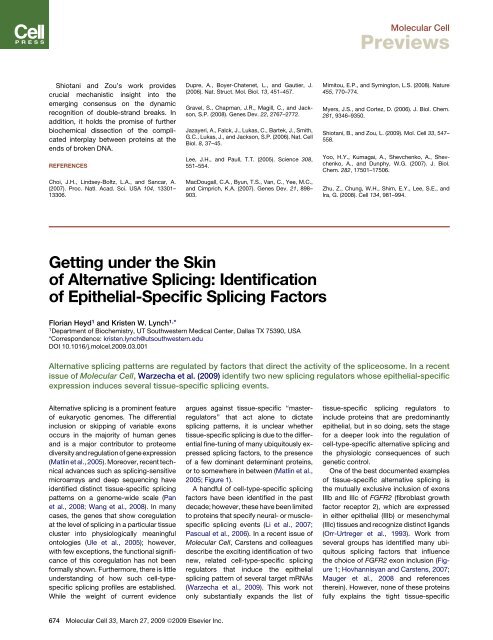
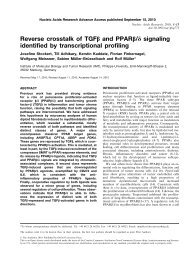

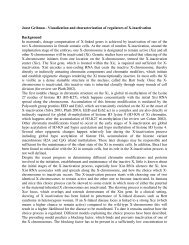
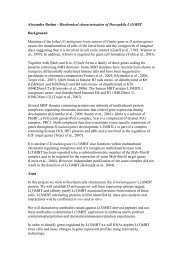
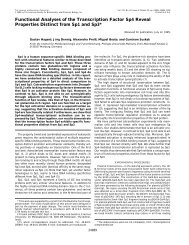
![2-(2-Bromophenyl)-3-{[4-(1-methyl-piperazine)amino]phenyl}](https://img.yumpu.com/22645635/1/190x248/2-2-bromophenyl-3-4-1-methyl-piperazineaminophenyl.jpg?quality=85)
